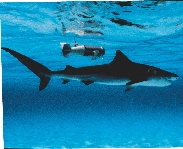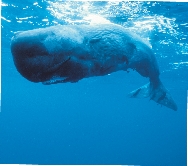Crittercam to the Rescue
Some scientists thought Crittercam wouldn’t work. Others worried that it might even harm animals. But the Crittercam team has proved that the cameras are safe. And we’ve learned a lot about ocean animals along the way. Here are just a couple of the things we now know about ocean animals thanks to Crittercam.
The Great White Mystery
The world of a great white shark comes into view with Crittercam. The shark’s head moves slowly from side to side. What is it doing?
What the Crittercam Found The shark is hunting. Exactly how the shark is hunting is an important discovery. It looks for outlines of fish or seals. The great white shark speeds up to attack when it spots a shape!

Crittercam is tethered to the shark’s dorsal, or top, fin.
A Whale of a Question
Sperm whales are fast divers. They can also travel hundreds of meters underwater. This makes them very hard to follow. It’s not hard for the Crittercam! So what did the camera discover?
What the Crittercam Found These whales talk to each other. They use clicks and high squeals to communicate. They also communicate using whistles and deep “huffing” sounds. The whales groom each other. They bump into each other hard enough to knock off pieces of loose skin.

A sperm whale surfaces. The whales dive deep in the ocean to find food.